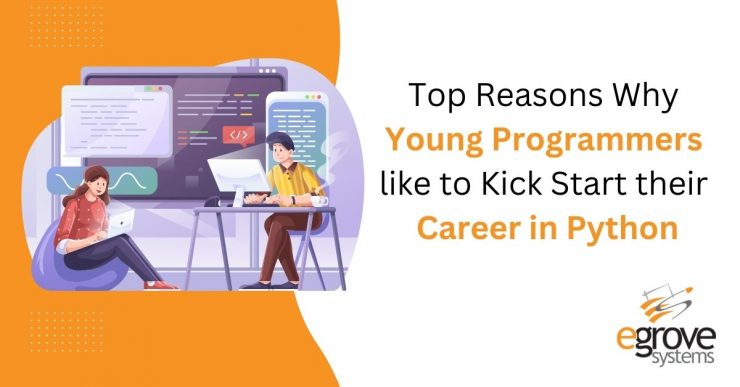Every software project must make many choices and compromises. The selection of which programming language to employ is one of the initial decisions. This choice can have a big influence on the performance of businesses whose main product is software.
A computer like-wise needs a collection of instructions to process and carry out various functions, just as a set of instructions is required to teach procedures for carrying out various jobs. The language used in these instructions is a programming language.
Programming Languages help computers with the input set of codes and use it to generate complicated programs and web architectures. These languages are the backbone of any computer program designed to automate repetitive digital tasks. One programming language that stands out from the rest is Python due to its ease of use, clarity of structure, and simplicity
One programming language stands out from the rest among the many others created to aid in computation: Python. Python is distinguished by its ease of use, clarity of structure, and simplicity.
Python Programming Language
Python is an interpreted dynamic semantics object-oriented high-level programming language. It is especially appealing to use as a scripting or glue language for connecting existing components due to its built-in high-level data structures, dynamic typing, and dynamic binding.
Python’s simple, clear syntax puts readability first and lowers the cost of program maintenance. Python offers packages and modules that encourage the modularity and reuse of code in programs. On all major systems, the Python interpreter and comprehensive standard library are freely distributed in source or binary form.
You may step through your code, evaluate arbitrary expressions, and look at local and global variables with the source code debugger. Debuggers created in Python serve as examples of the language’s introspection features. On the other hand, because it enables a quick edit-test-debug cycle, adding a few print statements to your source code is frequently the quickest method to debug your application.
Numerous practical applications deploy Python. It drives some of the biggest tech firms, including YouTube, IBM, Netflix, and Facebook. It is utilized in fields like data science, software development, game development, and artificial intelligence, which are predicted to see future changes like employment.
Regardless of one’s job choice, knowing Python programming is a need. In every job field, it provides a competitive edge. Anyone can learn how to write in Python with consistency and determination, including teens.
5 Reasons Why Young Programmers Prefer Python to kick-start their career:
1. Python is simple to learn, read, and write:
Python is simple to learn, and even for young programmers. C, C++, Java, etc., and other programming languages are not easy to learn. Python’s relatively basic instructions and syntax make it easy for youngsters with no coding knowledge to get started. Python is simpler than other natural languages because it is more like them.
Because of its user-friendly architecture, it can create lines of code in a lot fewer steps than with other programming languages. Python programming landed in second place after HTML in a WP engine poll of 909 developers to determine which programming language is the simplest to learn.
2. Python programming is flexible and adaptable:
A website, desktop or mobile apps, and even hardware programs, may all be created using the Python programming language. Programming in it may be done in many different ways. Python programming is said to be the best for web development since it integrates quickly with other web development languages like PHP, ASP, etc. It also includes excellent frameworks like Flasks, Pylons, and Django, among others, all of which make web development simple for python. Furthermore.
Python offers versatility that exceeds anything that can be imagined. Windows, Linux, and macOS are just a few of the systems it can run smoothly. Python may also be embedded in other programs and used in conjunction with C/C++. This implies that Python may be made to support more languages. No matter how experienced they are with Python, your child may attempt to create something new. Python allows young programmers to almost accomplish anything.
3. Python programming assists young learners with math:
Most people agree that one of the hardest topics for youngsters to learn in school is math. Python programming makes it simple and easy to apply math. Youngsters who learn to code are better equipped to understand how arithmetic is used in real-world situations. As young programmers learn to code, they come across math issues that they must answer, giving them the opportunity to use their logical reasoning and higher-order abilities.
Python may be used to start tackling math problems with only the most basic math abilities. young programmers will increasingly examine subjects like statistics and calculus that were once exclusively accessible to a select few in the coming years. We will undoubtedly witness smarter young brains as young programmers learn how these concepts apply in the real world through coding.
Read also:Why Should You Prefer Python for Development?
4. Python is a very effective language for ML and AI in young people:
The ability to teach young programmers Python programming has created new opportunities for teaching them to comprehend and interact with data. With the help of Python’s extensive libraries, such as Pandas, Numpy, Matplotlib, and Scikit-learn, young programmers now have more opportunities to unlock the mysteries of data. AI and machine learning are all about using data effectively to make choices on our behalf. Python is the only programming language that is well suited for working with data.
5. Future potential for teaching youngsters Python programming
The future employment prospects for young programmers learning Python are numerous. The use of Python in many demanding industries has already opened many professional opportunities and will continue to do so.
Python is widely used in his web development for famous online apps such as YouTube and Instagram as well as Google, the most widely used search engine. It is used in multiple industries and is expected to continue to be used in the future.
Mastering Python will greatly improve your child’s future employment prospects. Python programming is a necessary skill for everyone, regardless of career choice. Gain a competitive edge in any workspace. Teenagers and non-teens alike can be successful with perseverance and dedication.
Some Interesting Stats about Python language:
Python has been voted TIOBE’S programming language of the year 2021 for the second consecutive year with a year-end rating of 13.58 percent on the TIOBE index. Python’s popularity increased 1.86 percent over the previous year.
Beginning in the year 2021 at third place on the popularity meter, Python rose to the top position in October.
The most popular language according to TIOBE’S rankings right now is Python, which has established itself as a standard in data science, DevOps, and web development. At the beginning of 2021 at third place on the popularity meter, Python rose to the top position in October.
Swift, Go, Rust, and Kotlin are recognized as languages on a rising trend in the index by TIOBE, a company that offers software quality services.
The following were the top 5 languages as determined by the TIOBE index for January 2022:
Python is at 13.58%
C is at 12.44 %
Java is at 10.66 %
C++ is at 8.29 %
C# is at 5.68 %
Python was ranked first this month in the Pypl Popularity of Programming Language index, which examines how frequently language lessons are searched for on Google.
For January 2022, these were the top five rankings:
Python is at 28.74 %
Java is at 18.01 %
JavaScript is at 9.07 %
C/C++ is at 7.4 %
C# is at 7.27 %
Conclusion:
Introducing youngsters to Python programming will not just benefit their programming performance, but could also pave the way to a successful future career. Python programming encourages young programmers’ creativity and development by allowing them to experiment and gain confidence in their ability to innovate new techniques for the betterment of society.
















Add comment